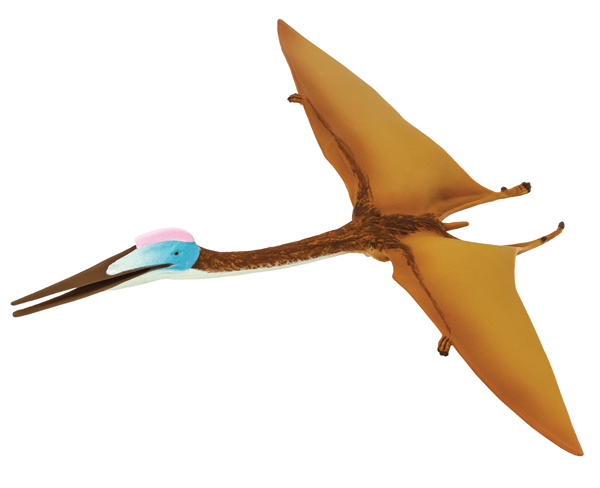New Research Suggests Pterosaur Anatomy Could Inspire Aviation Engineers
A new study suggests that pterosaur anatomy could inspire the next generation of aeroplanes. The microarchitecture of fossilised pterosaur bones could hold the key to lighter, stronger materials that can be used to make new types of aircraft. This is the remarkable conclusion made by scientists from the University of Manchester. Advanced and extremely powerful X-ray imaging techniques were utilised to reveal a complex network of microscopic canals inside the preserved bones of ancient flying reptiles. These structures make the bones exceptionally light but incredibly strong. They are ideal material properties for use in the aviation industry.

Pterosaur anatomy could inspire the next generation of aeroplane designs according to a new study. Picture credit: Nathan Pili, The University of Manchester.
Picture credit: Nathan Pili, The University of Manchester
Examining Pterosaur Anatomy at the Microscopic Level
The researchers claim that these pterosaur adaptations could have the potential to start a “palaeo-biomimetics” revolution using the biological designs of prehistoric creatures to develop new materials for use in the aeronautics industry. The paper has been published in the journal “Scientific Reports”.
Lead author of the study, Nathan Pili, a PhD student at the University of Manchester commented:
“For centuries, engineers have looked to nature for inspiration, like how the burrs from plants led to the invention of Velcro. But we rarely look back to extinct species when seeking inspiration for new engineering development, but we should. We are so excited to find and map these microscopic interlocking structures in pterosaur bones, we hope one day we can use them to reduce the weight of aircraft materials, thereby reducing fuel consumption and potentially making planes safer.”
Pterosaurs first evolved in the Triassic. They were close relatives of the dinosaurs and members of the Archosauria clade. Pterosaurs were the first vertebrates to achieve powered flight. Whilst many Triassic and Jurassic taxa typically had wingspans of less than two metres, many Cretaceous pterosaurs were giants.
The picture (above) shows a replica of the giant azhdarchid pterosaur Quetzalcoatlus. The figure is from the Wild Safari Prehistoric World range.
To view this range of prehistoric animal figures: Wild Safari Prehistoric World Figures.
Quetzalcoatlus lived during the Late Cretaceous and it had a wingspan of around ten metres. This huge size meant that these reptiles had to solve multiple engineering challenges to get their enormous bodies airborne. For example, their huge wing membrane was supported predominantly from a single, elongated finger.
X-ray Computed Tomography
The researchers used advanced X-ray Computed Tomography (XCT) to scan the pterosaur anatomy at the molecular level. The technique enabled the team to examine complex structures approximately twenty times smaller than the width of a human hair. Three-dimensional mapping of the internal structures permeating the wing bones of pterosaurs has never been achieved at these high resolutions (~0.002 mm).
The team discovered that the unique network of tiny canals and pores with the bones, once used for nutrient transfer, growth, and maintenance, also helped to protect against microfractures by deflecting cracks, serving both biological and mechanical functions. By replicating these natural designs, engineers could not only create lightweight, robust components but could also incorporate sensors and self-healing materials, opening up new possibilities for more complex and efficient aircraft designs.
The team propose that advancements in metal 3D printing could turn these ideas into reality. Pterosaur anatomy could permit an exciting new avenue for further research.
Nathan Pilli added:
“This is an incredible field of research, especially when working at the microscopic scale. Of all the species that have ever lived, most are extinct, though many died out due to rapid environmental changes rather than ‘poor design’. These findings are pushing our team to generate even higher-resolution scans of additional extinct species. Who knows what hidden solutions we might find!”
Learning from Darwinian Natural Selection
Senior author of the study, Professor Phil Manning (University of Manchester), explained:
“There is over four billion years of experimental design that were a function of Darwinian natural selection. These natural solutions are beautifully reflected by the same iterative processes used by engineers to refine materials. It is highly likely that among the billions of permutations of life on Earth, unique engineering solutions have evolved but were lost to the sands of time. We hope to unlock the potential of ancient natural solutions to create new materials but also help build a more sustainable future. It is wonderful that life in the Jurassic might make flying in the 21st century more efficient and safer.”
We need to develop stronger, lighter and more fuel-efficient materials. Pterosaurs may hold the key to the future of powered flight. By examining the first vertebrates to achieve powered flight we might be able to pave the way for a new generation of aviation technology.
Everything Dinosaur acknowledges the assistance of a media release from the University of Manchester in the compilation of this article.
The scientific paper: “Harnessing 3D microarchitecture of pterosaur bone using multi-scale X-ray CT for aerospace material design” published in Scientific Reports.
The Everything Dinosaur website: Prehistoric Animal Models and Figures.


